Our classic French rolled omelette takes some time to master but it’s a great meal in a pinch. With just a handful of ingredients, this is a recipe you’ll want to make again and again in your home kitchen.

While we were nomadic for three years, we made it a personal mission to perfect (or at least improve) our French omelette game.
The challenge was real since most short-term apartments don’t have great kitchens. However, we could always find eggs, butter and fresh herbs at local markets in countries like Vietnam and South Africa as well as in Europe.
During those nomadic years, we ate rolled omelettes of varying degrees of excellence and enjoyed most of them.
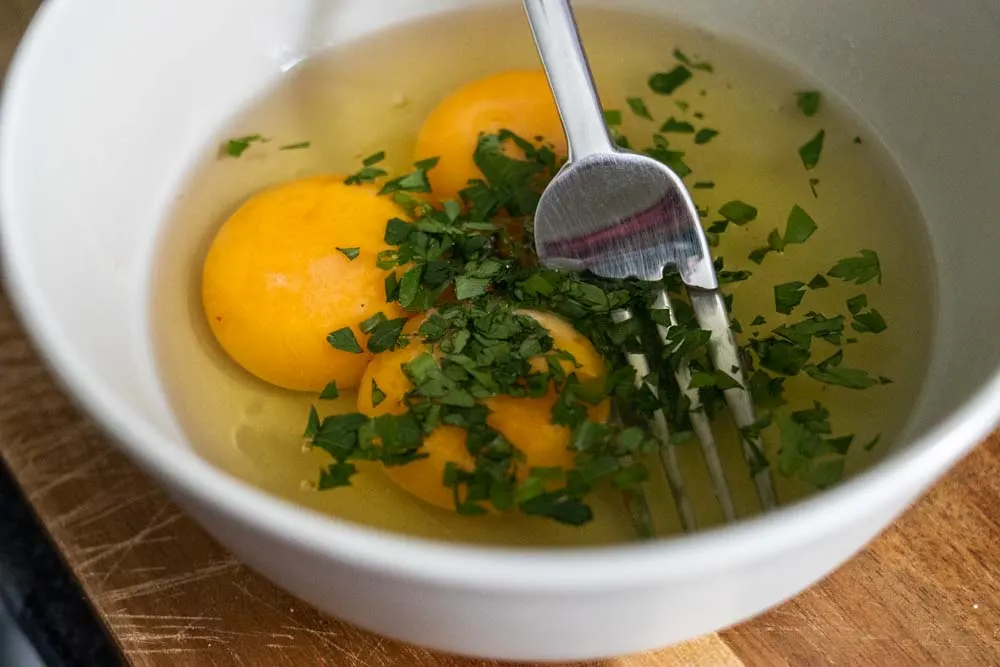
Now that we live in Portugal, our omelette journey continues with perfection not yet achieved. But, hey, with a little practice and technique, we’ve found that it’s entirely possible to make a creamy, satisfying rolled French omelette at home.
We have no more excuses. Not only do we have access to eggs so fresh that they occasionally have feathers attached, but we also have all of the necessary tools in our kitchen.
How Is A French Rolled Omelette Different From An American Omelet?

Growing up, omelettes were big, crescent-shaped egg dishes filled with a variety of ingredients. We often ate these behemoths at weekend brunches along with hash browns and other brunch food favorites. Our mothers filled their ‘western’ omelets with cheese, meat, vegetables and whatever else they had in the fridge.
We ate American omelets with gusto, unaware of their more refined cousins across the pond. However, our tastes evolved over the years. After exposure to great omelettes from Julia Child, Jacques Pepin and Daniel Boulud, in cookbooks and on TV, we knew that this was a skill worthy of a long-term cooking quest.
This isn’t to say that American omelets are wrong or don’t taste good. On the contrary. We’ll gladly eat a Denver omelet filled to the brim with meat, cheese and veggies at a typical American diner.
But French omelettes are a simple, yet refined, pleasure that elevates two basic ingredients, eggs and butter, to something magical.
What Is A French Rolled Omelette?

France can’t claim credit for inventing the omelet. However, with its Omelette Roulée (i.e rolled omelette), the country elevated the breakfast food staple to a higher level.
Chefs at Paris restaurants take pride in making perfect omelettes that are simultaneously simple and challenging to create. Food travelers can enjoy them at many of the city’s cafes and restaurants.
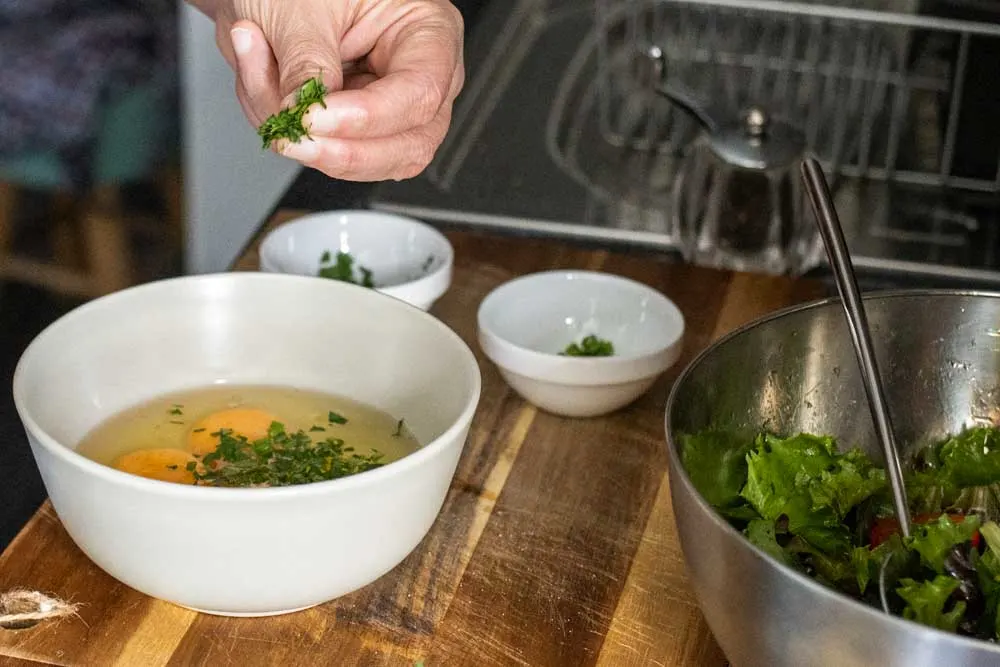
A rolled omelette’s ingredients can be counted on one hand – eggs, butter, herbs, salt and pepper. Cheese is not part of a classic omelet recipe but young cheese like Cheddar, Gruyere or Emmental can be added for an oozy, stretchy protein hit.
Pro Tip
You can add cheese to your rolled omelette. Grated, young cow’s milk cheeses like Gruyere, Cheddar and Emmental work well as do Boursin, fresh Chevre and even Brie.
You can easily follow our recipe and make a French omelette that tastes good. With a little practice, you can make a French rolled omelette that’s world-class gorgeous.
Rolled Omelette Meal

Unlike Americans, the French don’t exclusively eat omelettes for breakfast and brunch. Sometimes they plate the buttery egg dish with salad and eat it with a baguette and glass of wine.

French omelettes pair well with Chardonnay, Rhone-style Grenache and other white wine varietals. As an alternative, hot climate wines like Sauvignon Blanc provide a pointed acidy counterpoint to the rich, buttery eggs.
How to Make A French Rolled Omelette

Chefs often start their culinary training by learning how to make a perfect rolled omelette and later ‘audition’ for jobs by demonstrating their omelette technique. Home chefs like us can make the classic dish too.
Professional chefs who have ‘mastered’ the technique have, most likely, produced hundreds, if not thousands, of omelettes in their culinary careers.
Side Note
Don’t feel unworthy or untalented if you don’t create a perfect omelette the first time. In fact, the more omelettes you produce, the more you’ll find your own way, creating subtle variations using the pan, utensils and even ingredients of your choosing.

Much like learning a Beethoven sonata, the key with rolling omelettes is to practice, practice and practice some more. Your skill will improve with each omelette you create and you will rarely tire of your eggy creations.
But also like learning a great piano piece, it’s important to nail the fundamentals. Making French rolled omelettes will teach you the basics of heat, how to properly season your food, how to beat eggs and valuable pan-flipping skills.
French Rolled Omelette Basics
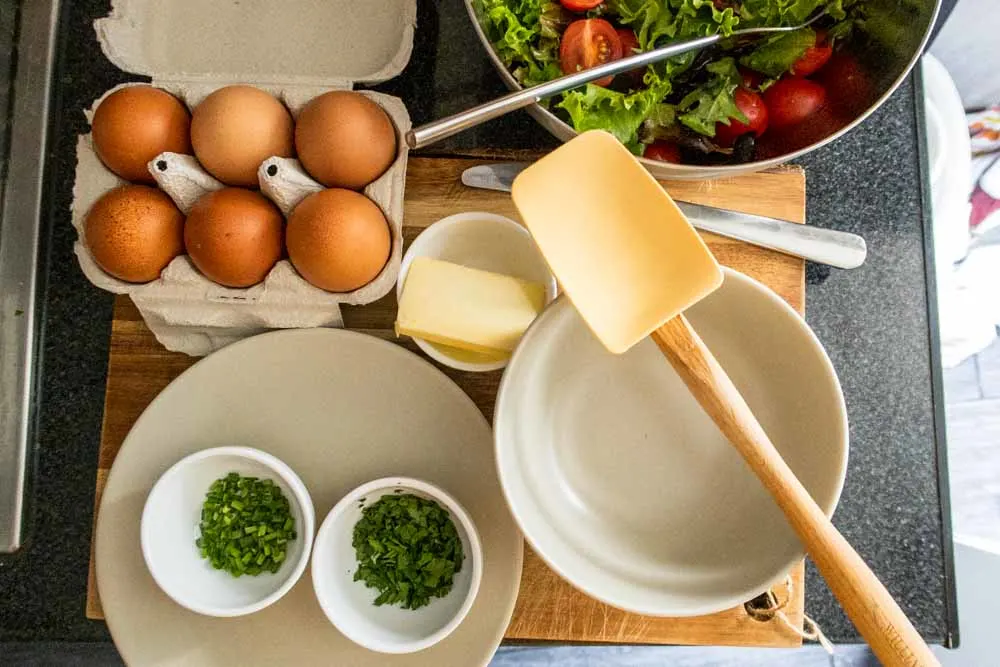
You’ll want to start this recipe by preparing the mise en place. This organization will allow you to quickly whisk the egg and herb mixture before adding it to a pan coated with melted butter.
Before beating, season your eggs with salt and pepper. Since eggs generally take a good amount of salt, we recommend adding a generous pinch of fine sea salt to taste. You’ll learn to salt your eggs with practice.
Many chefs prefer seasoning their eggs with white pepper as not to ‘muck up’ the appearance of the finished eggs. We use fresh ground black pepper at home and our omelettes look great.
Pro Tip
It’s important to beat the eggs in a back and forth motion until all the whites are incorporated. Most cooks traditionally use a fork for beating but there’s nothing wrong with using a whisk if you have a large bowl.
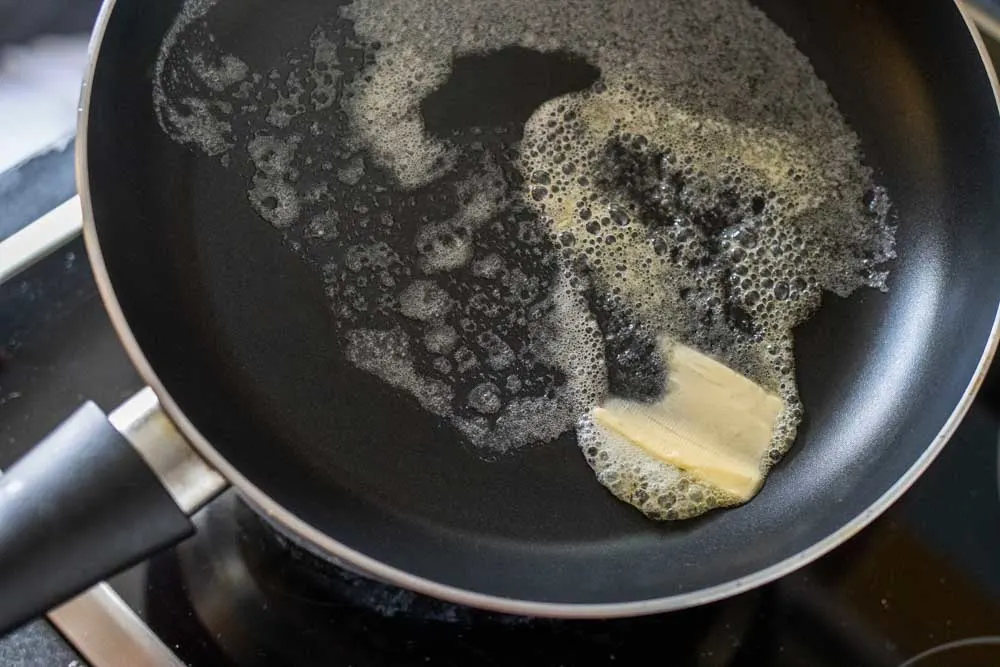
Heating and melting butter in a nonstick frying pan is the first, and most crucial, step in the cooking process. You’ll want your pan hot enough that the butter slightly sizzles when added.
The butter should move slowly across the pan with a gradual yet discernable bubble. An overly hot pan will force the butter to heat too quickly and brown.
Pro Tip
You can correct an overly hot pan by immediately removing it from your burner. If your butter browns too quickly, we recommend carefully wiping the butter out of the pan with a clean, dry dishtowel or dry paper towel and starting over.
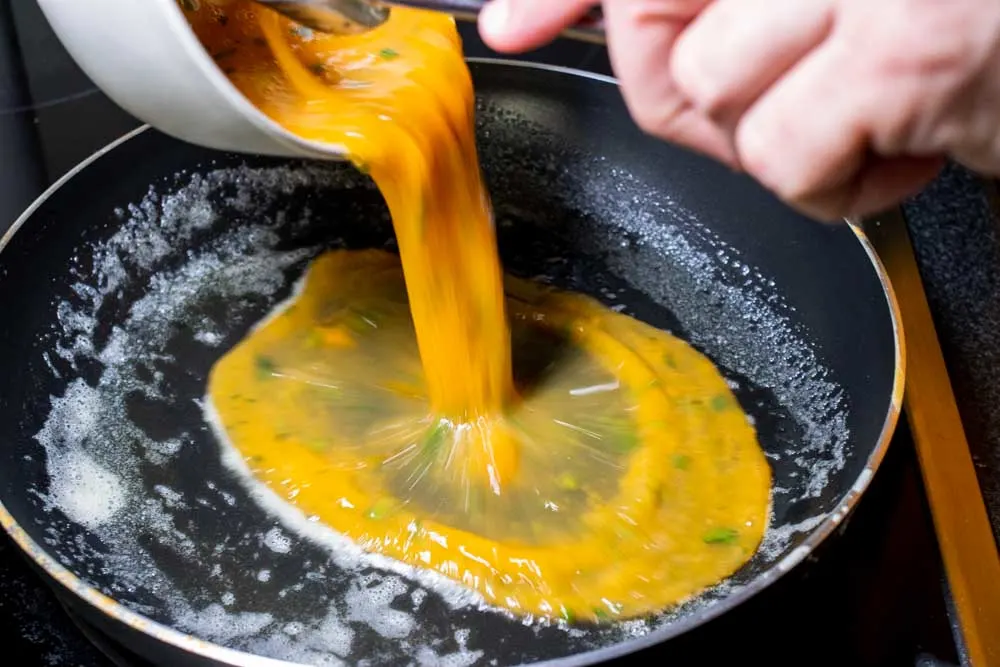
The magic happens in the pan as the eggs quickly solidify. You won’t stop moving during this process – shaking the pan with one hand and stirring with the other.
You’ll want to shake the pan back and forth toward you, vigorously, while making a figure 8 with a fork or spatula to form a light custardy curd. Crucially, you’ll also want to use a utensil to push the eggs off the slope of the pan toward the center.
To us, this is the most overlooked step and the reason why a rubber spatula is highly effective in this recipe.
Since you don’t want to over-heat the eggs, knowing when to stop mixing is part of the learning process. Once again, if the eggs over-solidify, you may want to wipe out the pan and start over.
Friendly Suggestion
If your omelette doesn’t set and you don’t want to waste food, you can always settle for a light scramble and save the French omelette fight for another day.
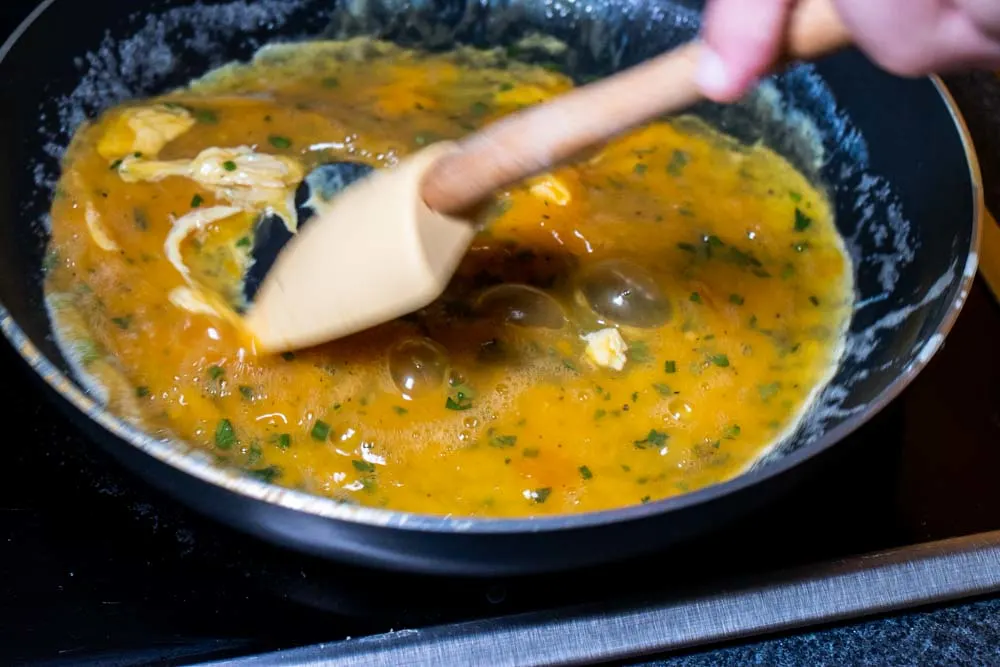
Before you know it, it’s time to roll the eggs and form an omelette. Knowing when to stop mixing to let your eggs set is another part of the learning process.
You’ll want to make sure the eggs settle into a round disk with a liquidy layer of custard curds on top. (See photo below.)

Let the eggs sit for about a minute until the bottom just solidifies. Run your utensil around the outer edge of the omelette to make sure the eggs have separated from the bottom of the pan.
Once you feel that the bottom of the eggs are set, you can begin rolling the omelette to the other edge of the pan, making sure to roll the edges evenly from all sides.
Pro Tip
Stop rolling once you’ve left about an inch unrolled on the edge of the pan. The goal is to form a crescent shape.
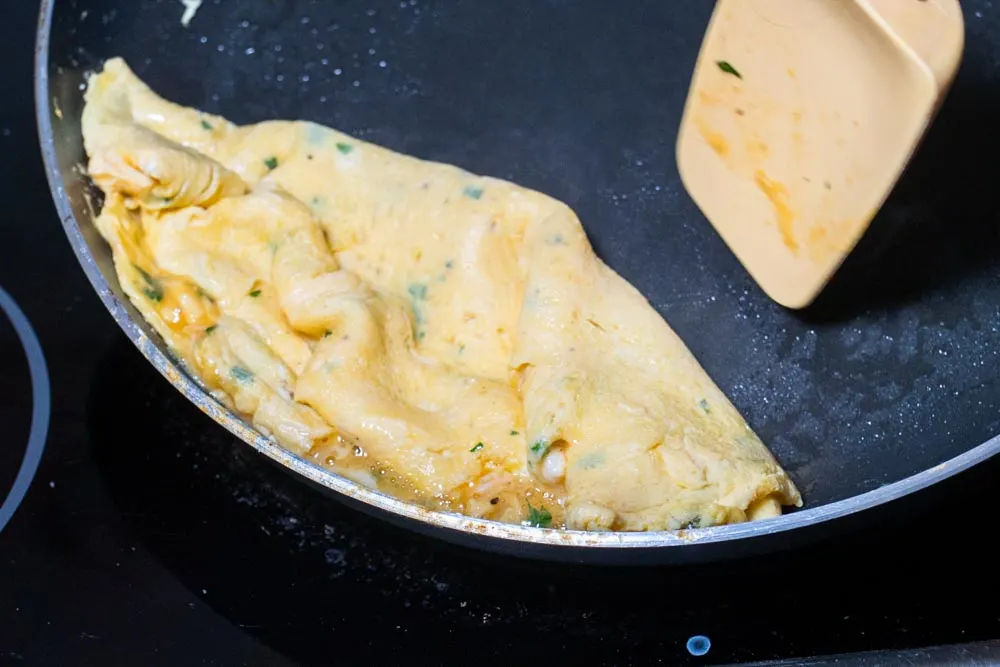
Crucial step: Move the pan away from the stove and, while holding the pan handle with one hand, bang your fist against the handle, in a hammering motion, with your other hand forcing the final edge of the omelette to separate from the pan.
Have your serving plate at the ready. You’ll need to move quickly.
Pro Tip
You can watch ‘how to cook an omelette’ videos on YouTube to observe the proper omelette rolling technique. However, you’ll learn how to do it in real life via trial and error in the kitchen.
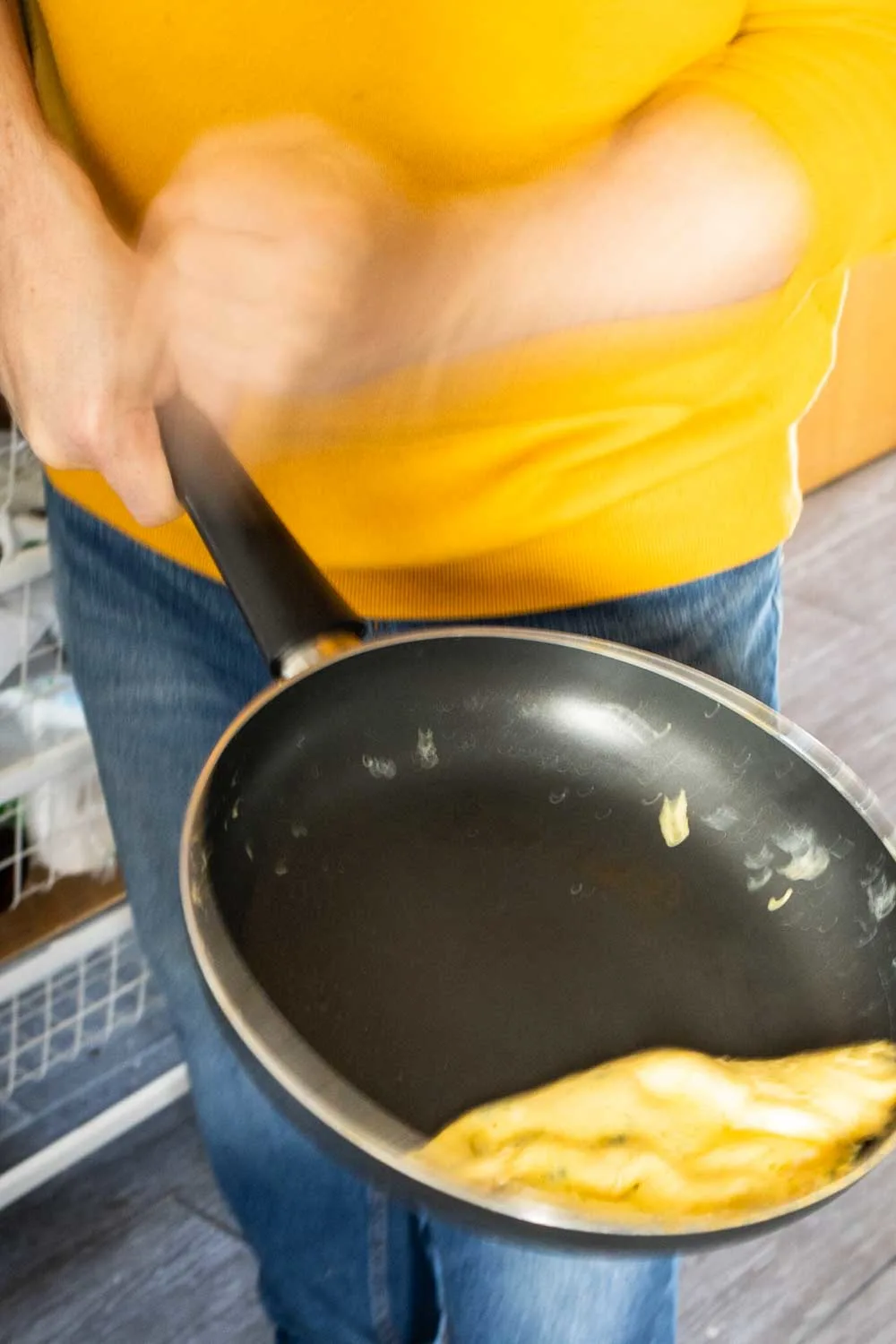
Next, turn your eggs onto the serving plate by inverting your pan while tilting the plate. If you followed the previous steps, your eggs should fall naturally forming the final omelette shape. If not, you’ll get it right next time.
Sometimes your rolled omelette shape will look picture-perfect and other times it won’t. But the more omelettes you make, the better your omelettes will look.
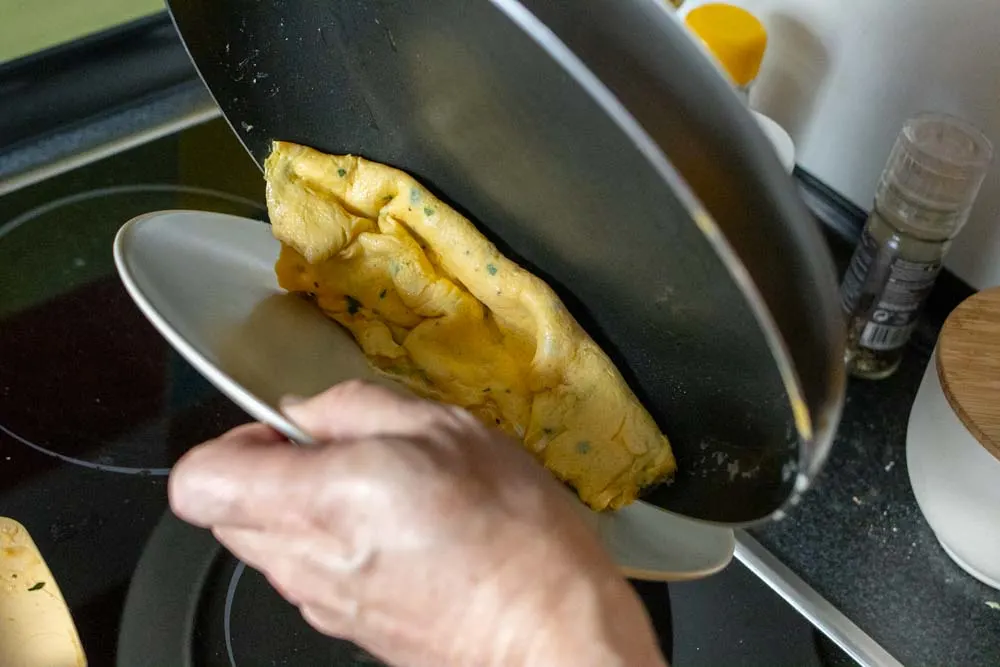
Once your omelette has hit the plate, rub the outside with a pat of butter. Finally, add a garnish of fresh herbs.
We like to finish our omelettes with finely chopped chives.
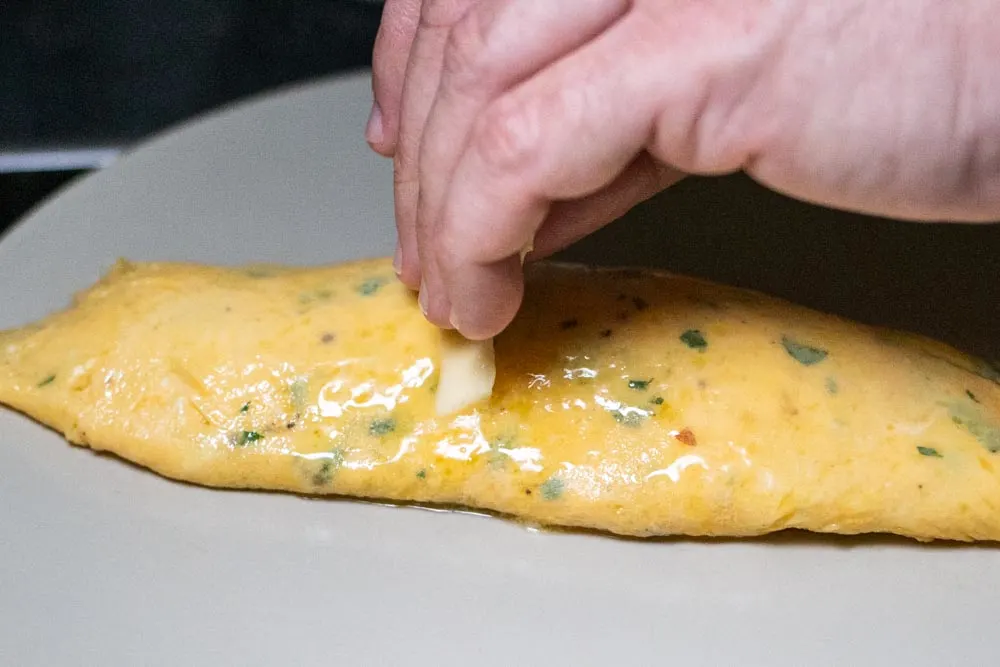
Voila! You’re now ready to dig into your omelette. And the best part? Not only will your homemade omelette taste good but it will also cost way less than eating one at a restaurant.
The total cost should be under $5 even if you add cheese and other basic accoutrements.
Notes
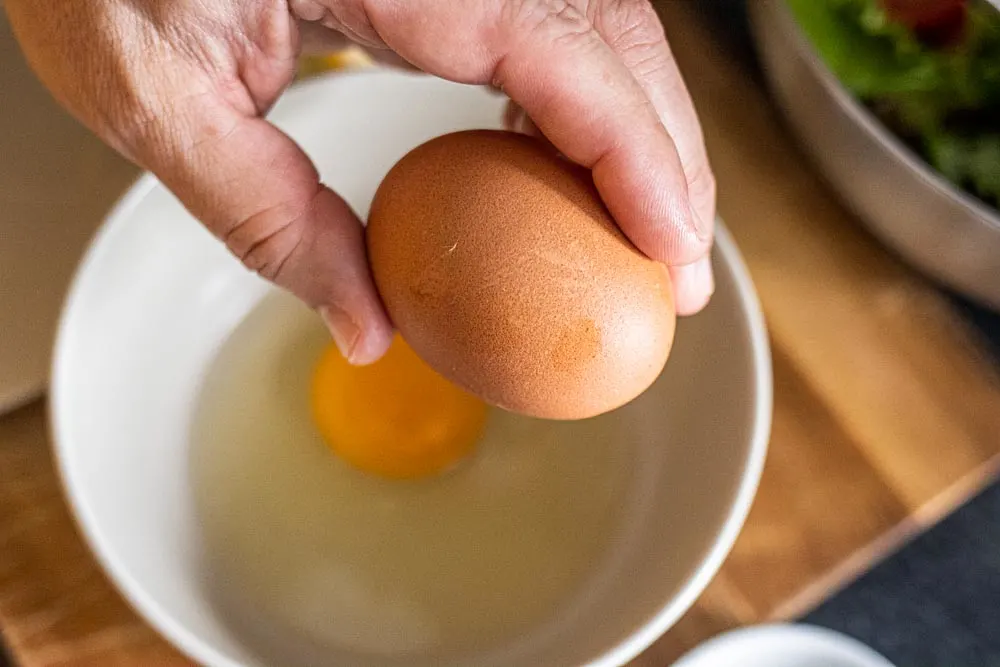
Since our rolled omelette recipe only requires a handful of ingredients, it’s important that you use the freshest available product. This is easy to do in Lisbon where beautiful, rich, orange-yolked eggs are sold in good markets and grocery stores.
We use room temperature eggs for the recipe since eggs in Portugal, as in European countries like France and Italy, are sold unrefrigerated. Industrial egg producers here choose not to wash the special protective coating off the eggs.
If you follow this recipe in the US or UK, you can warm refrigerated eggs by soaking them in lukewarm water for about an hour.
Pro Tip
Source the freshest eggs possible wherever you’re located. Consider buying room temperature eggs at a local farmer’s market. Many farmers don’t wash off the outer egg coating.
Best Utensil For Making French Rolled Omelettes
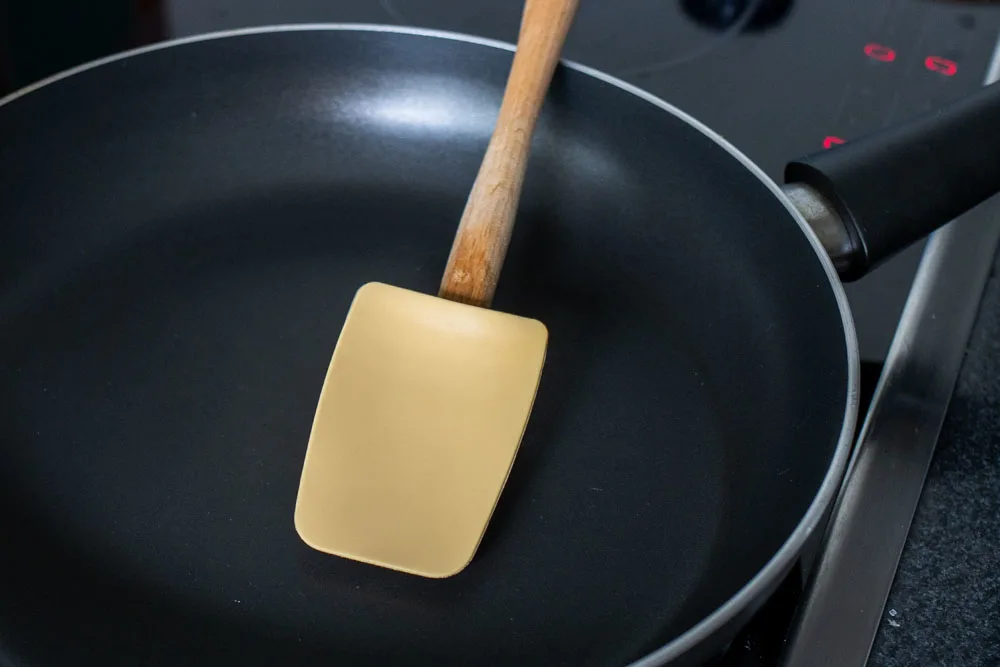
Many chefs and restaurant professionals (including Daryl’s brother Lou) insist that you must use a fork when making a French rolled omelette. We respectfully disagree.
While using a fork or fork-like utensil may result in a smaller curd and slightly fluffier omelette, we’ve found that creamy, dreamy results are just as achievable with a spatula. In other words, you don’t have to scratch your pan.
In our Lisbon home kitchen, we use a yellow silicone spoonula that we bought in Philadelphia years ago. We like this utensil because it doesn’t damage our non-stick pan and is easy to clean.
Pro Tip
You can use a carbon steel or cast iron pan if you don’t have a non-stick pan. However, be aware that these pans are heavy and may require seasoning.
Additional Ingredients
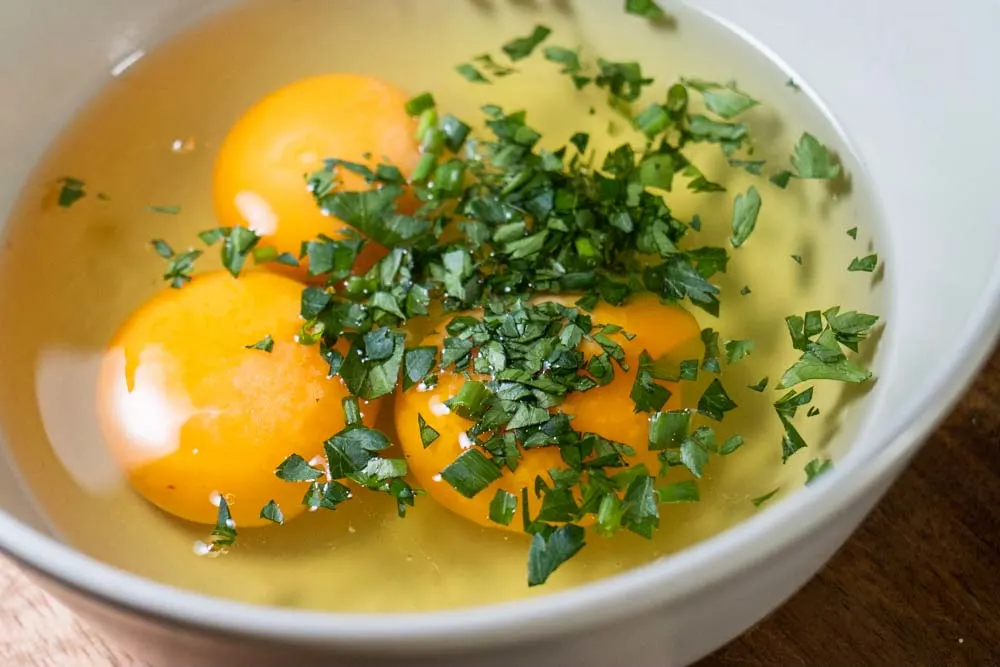
You can add herbs of your choice to the recipe. We recommend leafy herbs like parsley, tarragon or basil. Julia Child used ‘fines herbes’ – a mix of parsley, chives, tarragon, and chervil.
Our favorite herb is tarragon. However, since fresh tarragon is not widely available in Lisbon, we used fresh, chopped, flat-leaf (Italian) parsley instead. We typically finish our omelettes with chopped chives.
Occasionally, Daryl goes crazy and adds cheese. Mindi pushes the envelope even further by sprinkling Piri Piri sauce on top of her rolled omelette. It doesn’t matter what we add since the only people we need to please are ourselves.
Pro Tip
When you make this recipe in your omelette pan, modify it to fit your own taste preferences.
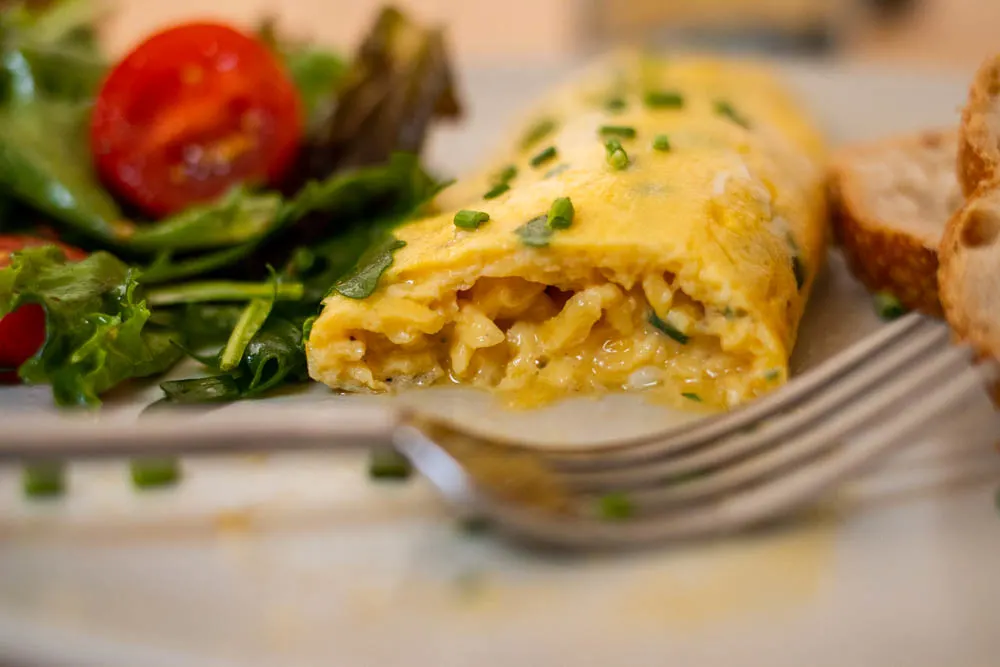
We use a simple recipe inspired by culinary icons including Jacques Pépin and Julia Child. We’ve modified it based on the availability of herbs and equipment here in Portugal.

Budget 15 minutes for the recipe. You’ll want to read the directions first so that you can move quickly. Before you know it, you’ll be making and eating classic French rolled omelettes at home.
Did you make this recipe? If so, please rate it below.
French Rolled Omelette Recipe
Ingredients
- 3 eggs (large)
- 2 tablespoons butter (unsalted)
- ¼ cup fresh herbs (finely chopped)
- ¼ cup chives (finely chopped)
- pepper (white or black)
- salt (kosher or fine sea salt)
Instructions
- Crack eggs into a small mixing bowl and add fresh herbs. Whisk with a metal fork until thoroughly blended and add a healthy amount of salt and pepper to taste.
- Heat a non-stick pan over medium heat for about 5 mintues until it’s hot. Add butter. The butter should lightly sizzle and move slowly when entering the pan. If the butter melts too quickly, move the pan off the heat to cool. If the butter browns, wipe the pan with a paper towel or a clean kitchen towel and start over.
- Pour egg mixture into the pan. Once the eggs begin to set, start mixing with a silicone spatula or fork. Simultaneously shake the pan back and forth with one hand and stir the eggs, in a figure eight pattern, with the other hand until the eggs form a liquidy custard. Don't let the eggs over-solidify or you'll end up with scrambled eggs. At the end of the custard phase, your eggs should form a disc shape that covers the bottom of the pan.
- Let the eggs solidify on the bottom of the pan for about a minute. This is a good time to grab a serving plate from the cabinet
- Begin rolling the omelette toward the outer edge of the pan, leaving about two inches unrolled toward the edge.
- Take the pan off the heat and, while holding the pan in one hand, bang your fist against the pan handle using a hammering motion to loosen the omelette from the other side of the pan.
- Tilt and invert the pan in one hand and slightly tilt your plate in the other, letting the rolled omelette fall onto the plate. Tweak as necessary if the shape doesn’t look quite right.
- Brush the top of the omelette with a pat of butter and then sprinkle chives (or herb of your choice) over the lightly buttered omelette.
Pro Tips
- Many European countries use room temperature eggs. If your eggs are refrigerated, you can warm them to room temperature by immersing them in lukewarm water for an hour.
- You can use olive oil instead of butter depending on preference and availability. However, the texture and flavor will be different and the omelette will end up brown.
- You can use a well-seasoned carbon steel or cast iron pan instead of a non-stick pan though it may be heavy to handle.
- Cheese and other fillings are optional additions.
- Pair the omelette with a baguette, salad and white wine to create a special ‘light’ lunch.
Estimated Nutrition

About the Authors
Daryl and Mindi Hirsch
Saveur Magazine’s BEST TRAVEL BLOG award winners Daryl and Mindi Hirsch share their culinary travel experiences and recipes on the 2foodtrippers website. Since launching the site in 2012, they’ve traveled to over 40 countries in their quest to bring readers a unique taste of the world.
Original Publication Date: April 20, 2020



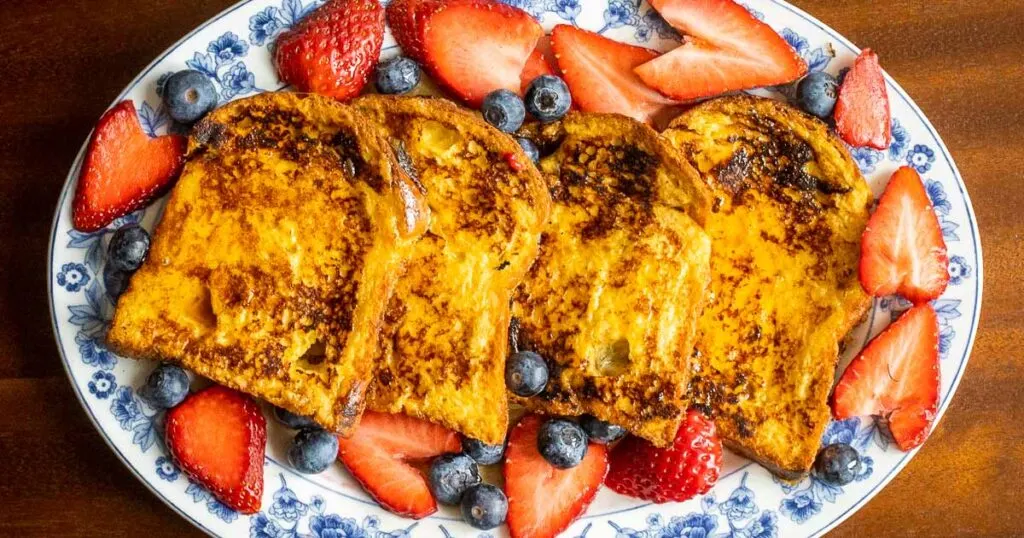

Steven
Thursday 13th of January 2022
You should look at YouTube for how the Japanese do their eggs.